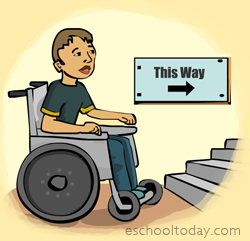 |
What is a disability?
Disability, Impairment, and Handicap are three words that many people use to mean one thing: A person who is unable to do things that many people do, because of a health impairment they have.
To better understand the issue of disability, let us consider these two models: Medical Disability and Social Disability.
 Medical Model Medical Model
Consider this scenario: John has difficulty hearing. It means he probably has an individual medical problem. We say John has a hearing impairment (or hearing loss). Note that at this stage we are not talking about disability. There are many people with many medical problems such as sight, movement, hearing and so on. We say they have a psychological, physiological or anatomical impairment. In this model, the person is the problem.
 Social Model Social Model
Assuming John went to the hospital and sat in the hospital waiting room without a prompter screen, waiting to be called—he would sit all day because he cannot hear if his name is called. If there were a prompter screen, he probably would have seen his name up. At this point, society has made him disabled, because the hospital did not provide reasonable considerations to people with hearing impairment. In this model, society is the problem.
From the two models above, we can learn that disability can be viewed in two ways: the medical impairment, or the little or unequal consideration given to people with impairment.
 Disability is, therefore,an umbrella term for any continuing condition (physical or mental impairment) that restricts a person’s everyday activity. Note that this is not only in relation to the person, but also the setting in which the person exists. Disability is, therefore,an umbrella term for any continuing condition (physical or mental impairment) that restricts a person’s everyday activity. Note that this is not only in relation to the person, but also the setting in which the person exists.
This makes disability fundamentally an issue of rights.
What about Handicap?
It is a disadvantage for a given individual, resulting from an impairment or disability, that prevents the fulfillment of a role that is normal depending on age, sex, social and cultural factors for that individual.
 
|
 |
